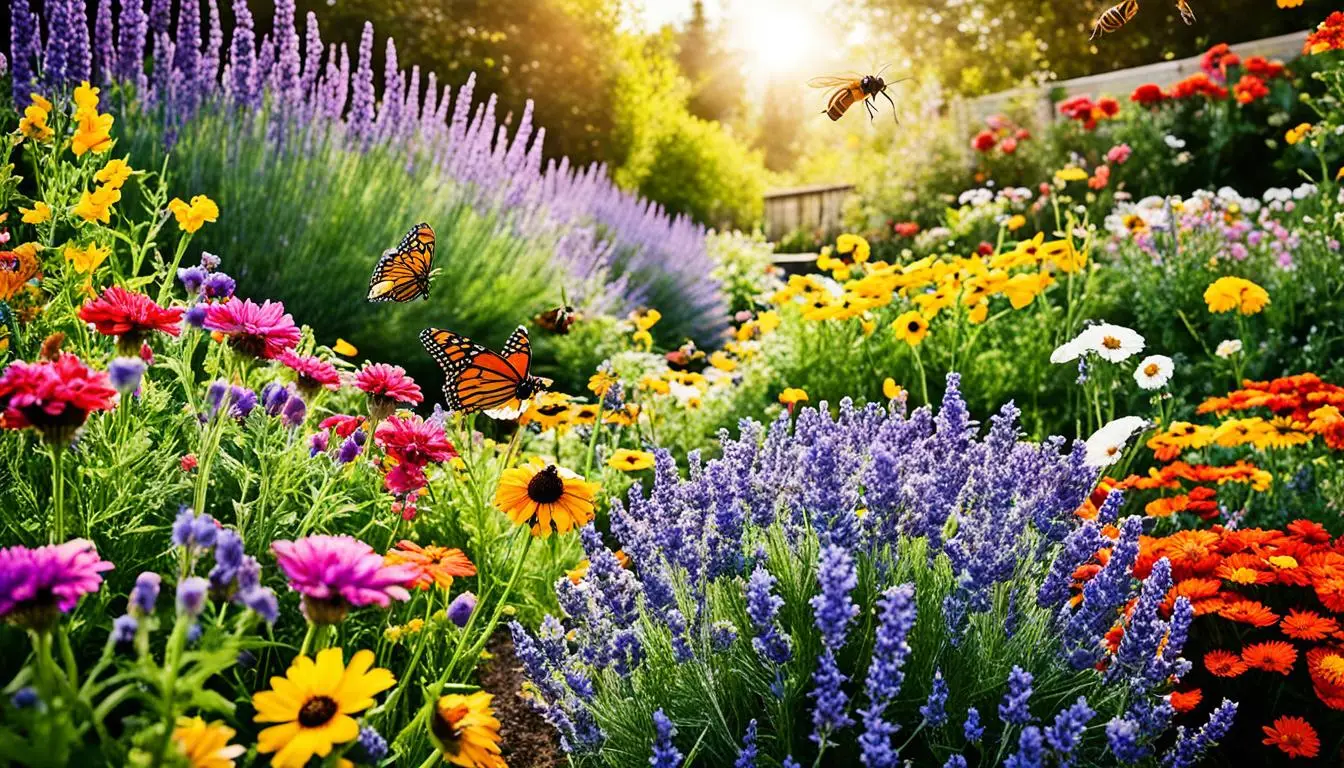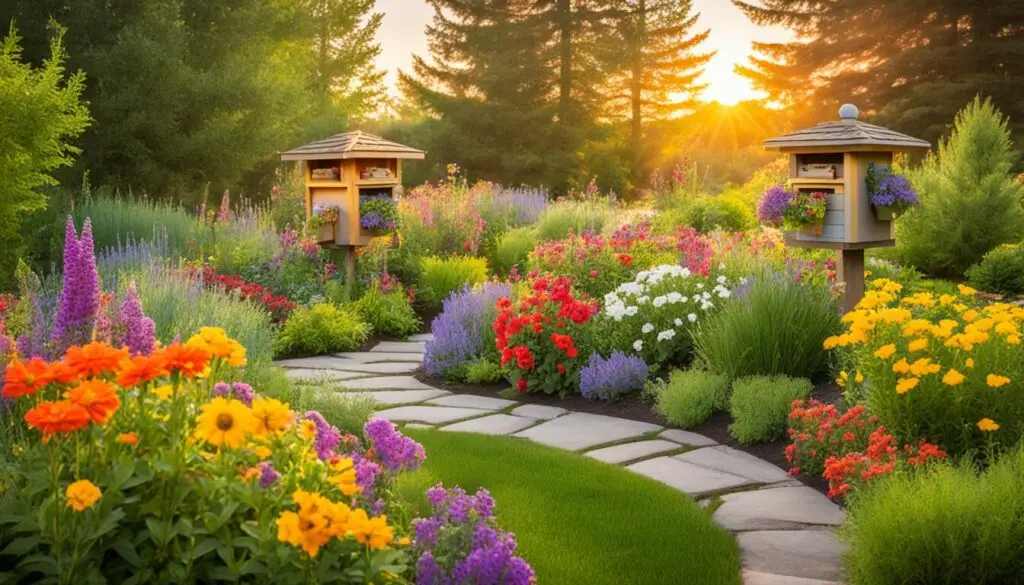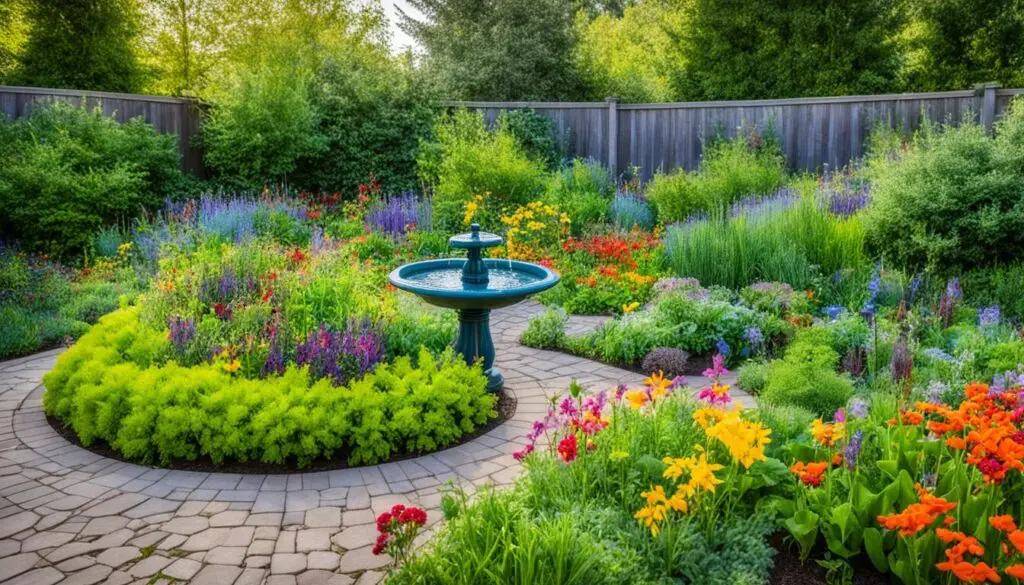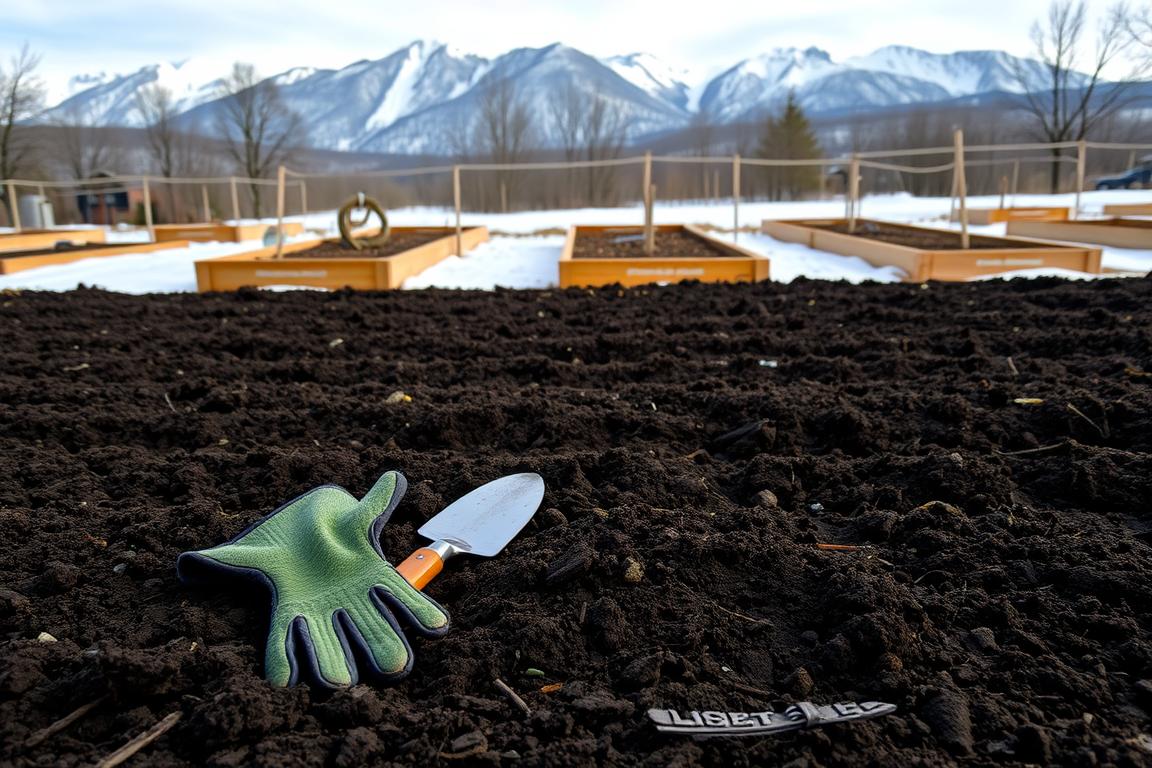If your garden’s activity seems lower lately, you’re not alone. Bees, butterflies, and bats are disappearing worldwide. This is bad news because these creatures help grow most of our food. Yet, while some problems are big, everyone can make a difference at home. You can transform your yard into a helpful place for these much-needed insects with a few changes.
Key Takeaways
- Bee, butterfly, and bat populations are facing alarming declines worldwide.
- Pollinators require safe spaces to feed and find mates, which can be provided in your own garden.
- Creating a pollinator-friendly garden can help support these crucial creatures.
- Simple steps like planting nectar-rich flowers and host plants can transform your garden into a haven for pollinators.
- Embracing sustainable gardening practices and reducing pesticide use can further benefit pollinators and the broader ecosystem.
The Importance of Pollinators in Your Garden
When you stand in the garden, you hear a buzz, whir, and whoosh. These sounds are creatures pollinating, feeding, and socializing. Bees, moths, butterflies, and many others serve as pollinators. To help them, we plant specific flowers in our gardens. This makes an ecosystem where plants and animals can live well together.
Roles of Bees, Butterflies, and Other Pollinators
Bees, butterflies, and other pollinators are very important. They help gardens and ecosystems grow and stay healthy. These creatures make sure plants are pollinated. This supports many different kinds of life and keeps nature in balance.
Declining Pollinator Populations and Their Impact
Unfortunately, the number of pollinators is getting smaller. This is because of things like losing their habitats, using too many pesticides, and climate change. We must create spaces in our gardens for pollinators. This helps their population and the areas where they live.
Creating a Pollinator-Friendly Environment
Stop stressing about having a perfect garden. Instead, create a home for wildlife. “Think about your garden as a habitat for wildlife rather than approaching it as ‘I need a nice and tidy manicured lawn,'” says Sylvia Fallon, a senior scientist with NRDC’s Land and Wildlife program.
Nature-friendly lawns and gardens can look beautiful. Don’t pull out everything just to keep it neat. Let some areas grow wild. Bees love clover, so let it be. And keep meadows of wildflowers where they are.
Leave-It-Alone Gardening: Embracing Natural Habitats
Use plants that help local pollinators. Those fancy, hybrid plants may not be as friendly. Learn about what grows well in your area. Fancy or simple, your garden should bloom all year.
Clumps of plants help pollinators. They make it easier for bees and butterflies to visit.
Incorporating Native Plants in Your Garden
Use plants that fit the needs of local pollinators. Exotic hybrids often lack what bees and butterflies need. Look for native plants that suit your yard.
Providing a Variety of Blooming Plants
For bees and butterflies, choose native plants with different blooms. They should flower from spring to fall. Instead of singles, plant in groups. This way, pollinators will notice your garden easily.
Avoiding Pesticides and Toxic Chemicals
Many pesticides, including the organic ones, hurt bees and other good bugs. You don’t have to use strong poisons on your garden. While these can quickly stop the bad bugs, they also harm the good ones. Long term, they put people, pets, and the environment at risk.
Choosing an organic approach is smart and works better. Use nature’s ways to fight off pests and sickness in plants. This keeps your garden and what lives in it safe. When you must use pesticides, be very careful. Don’t spray them where bees or other helpful bugs are.
Planting Nectar-Rich Flowers and Host Plants
To bring pollinators to your garden, start by planting the right flowers and plants. Pick plants that are good sources of nectar and pollen. These include wildflowers and old types of flowers. Make sure you have new flowers blooming all the time. This way, there’s always food for the pollinators. Also, add plants that caterpillars eat, like dill, fennel, and milkweed.
Flowers Attractive to Bees
Bees like to land on flowers with flat tops. They find it easy to collect pollen from these types. They are especially drawn to flowers like clematis. These have stamen that stick out. Bees see blues and purples best, not red.
Flowers Attractive to Butterflies
Butterflies also love nectar and look for specific-shaped flowers. They prefer flowers that are flat and clusters of tiny, tubular ones. Plants with bright colors like red, orange, and pink really catch their eye.
Host Plants for Butterfly Larvae
It’s essential to plant for caterpillars if you want to see butterflies. Include different plants to feed them through their whole life.
“Attracting Butterflies and Bees to Your Garden”
Including Milkweed for Monarch Butterflies
Back in 1997, over 1 billion monarch butterflies took flight from the United States to Mexico. They headed there for the winter. But today, we see less than 57 million making the trip. This sharp drop is mainly our fault, says Fallon. Our farming ways have changed a lot. One of the biggest harms is the loss of milkweed, the monarchs’ favorite and necessary plant. It’s the only plant where they can lay their eggs. You can help by growing milkweed in your garden.
Providing Water Sources for Pollinators
For attracting pollinators, especially in dry areas, a shallow pool helps a lot. It could be better than relying on the morning dew on your grass. If you use a birdbath, you’re already on the right track. Just add some pebbles or rocks into it. They will act as “islands”. This will save pollinators, especially tiny bees, from drowning.
Providing Shelter and Nesting Sites
Butterflies, bees, and other pollinators need shelter for protection and to raise their young. By adding nesting spots to your garden, you support important pollinator gardens and wildlife habitats. This helps keep the ecological balance.
Creating Nesting Boxes for Bees and Bats
Attract more pollinators by placing artificial nesting boxes in your garden. Use wooden blocks with holes for mason bees or a bamboo Mason Bee House. For bats, setup a Bat-Chelor Pad to help them breed. This also helps with insect habitats and pollinator conservation.
Allowing Dead Wood and Leaf Litter for Natural Nesting
Keep a part of your yard wild for ground-nesting bees by letting a hedgerow or lawn section grow naturally. Place a log or pile of grass in the sun for butterflies and solitary bees. Having dead trees adds nooks for them as well. These actions promote wildlife gardening and habitat creation. They help various native plant species and insect conservation.
Backyard Beekeeping
You don’t need a big farm to keep bees. A little space and some knowledge will do. Bees need water and lots of flowers nearby. If you’re willing to learn, you might enjoy this old hobby. Starting up takes a bit of gear and some know-how. But, for someone keen on beekeeping, it’s pretty doable.
By planting a bee-friendly garden and keeping beehives at home, you help bee populations. This is important for the wildlife around you. Your garden becomes a welcoming place for these tiny workers. Plus, it helps keep the ecosystem in balance.
Anybody can do backyard beekeeping with the right effort and tools. Getting the right gear and learning how to care for bees is key. This way, you get to protect these little pollinators. They are critical for our gardens and the world’s nature.
Sustainable Gardening Practices
Sustainable gardening is key to a lively space for pollinators. It’s important to go organic. This way, you keep your garden safe, help it flourish, and support insects like pollinators.
Organic Gardening and Pest Control Methods
Try talking to neighbors about stopping pesticide use. Together, you might change local rules to cut back on harmful sprays. This effort can really make a difference for pollinators and promote the sale of safe plants in stores.
Supporting Local Pollinator Conservation Efforts
Backing pollinator conservation locally by planting native and using less pesticides is crucial. It helps create a more resilient space for pollinators like bees and butterflies. This contributes to a better ecological balance.
Conclusion
Adding plants that pollinators love enriches gardens and helps these vital beings. It also fills the space with beautiful colors all year round. Make sure your garden also offers water and safe spots for pollinators. This way, you help keep them healthy and strong.
Giving pollinators what they need is simple and rewarding. Plant flowers rich in nectar and special host plants. This draws bees, butterflies, and more to your garden. Include native plants and use nature-friendly gardening methods. By doing this, you help create a place where both people and nature can thrive together.
Whether you’re new to gardening or have a green thumb, your work makes a big difference. It boosts your local area’s biodiversity and health. Let’s all step up and do our part to protect the homes of pollinators. This action ensures our gardens and the wild world around us both flourish for years to come.
FAQ
What are the roles of bees, butterflies, and other pollinators in a garden?
Bees, butterflies, and others pollinate plants. They help plants grow fruit and seeds. This supports the variety of life and keeps the balance in nature.
Why are pollinator populations declining, and what is the impact?
Loss of homes, pesticides, and climate change hurt pollinators. This makes it hard for them to survive. It also affects the health of plants and foods.
How can I create a pollinator-friendly environment in my garden?
Make space for wild plants and use local plants. Have many types of flowers that bloom at different times. Don’t use harmful chemicals.
Keep your garden welcoming for all kinds of pollinators.
What types of flowers are attractive to bees and butterflies?
Bees like flowers with flat tops and bright stamen. Look for blue and purple flowers. Butterflies prefer flowers full of nectar, like zinnias and butterfly weed.
How can I help support monarch butterfly populations?
Planting milkweed is crucial for monarchs. It’s their larva’s food and their home. This simple step can make a big difference.
What other features can I add to my garden to support pollinators?
Give them a place to drink, like a birdbath. Create homes for them too, with bee boxes and old wood. These additions welcome pollinators to your garden.
Is backyard beekeeping a viable option for the average gardener?
Yes, you can keep bees in your yard with the right space and care. It’s a good way to help pollinators and enjoy fresh honey. Just be ready to learn.
What are some sustainable gardening practices I can implement to protect pollinators?
Go organic. Cut down on pesticides. Support groups that protect pollinators. With these steps, your garden can be a safe and inviting place for everyone.








